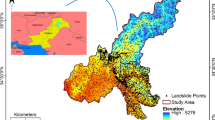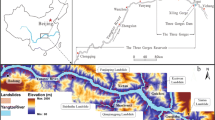Abstract
This teaching tool is to present how to generate the landslide susceptibility maps using binary logistic regression (BLR) and artificial neural network (ANN) methods at a regional scale. The study area is one of most landslide-prone areas in Japan. First, the landslide inventory data from the National Research Institute for Earth Science and Disaster Prevention (NIED) were randomly partitioned into two parts: training and testing data. Then, 10 m DEM data and geology map were analyzed to extract the landslide predisposing factors. Next, the susceptibility maps were produced in a geographic information system (GIS) environment. Then, the receiver operating characteristics (ROC) was used to assess the model accuracy. Validation results show that both of two methods can be obtained with acceptable results. The maps can provide useful information for the future planning of hazard mitigation.
Similar content being viewed by others
References
Ayalew L, Yamagishi H, Marui H, Kanno T (2005) Landslides in Sado Island of Japan: part I. Case studies, monitoring techniques and environmental considerations. Eng Geol 81:419–431
Chang T-C, Chao R-J (2006) Application of back-propagation networks in debris flow prediction. Eng Geol 85:270–280. doi:10.1016/j.enggeo.2006.02.007
Chung C-J, Fabbri AG (1993) The representation of geoscience information for data integration. Nonrenewable Resour 2:122–139. doi:10.1007/BF02272809
Costanzo D, Rotigliano E, Irigaray C et al (2012) Factors selection in landslide susceptibility modelling on large scale following the gis matrix method: application to the river Beiro basin (Spain). Nat Hazards Earth Syst Sci 12:327–340. doi:10.5194/nhess-12-327-2012
Dai FC, Lee CF (2003) A spatiotemporal probabilistic modelling of storm-induced shallow landsliding using aerial photographs and logistic regression. Earth Surf Process Landforms 28:527–545. doi:10.1002/Esp.456
Dou J, Oguchi T, Hayakawa YSS et al (2014) Susceptibility mapping using a certainty factor model and its validation in the Chuetsu Area, central Japan. Landslide Sci a Safer Geoenvironment 2:483–489. doi:10.1007/978-3-319-05050-8_65
Dou J, Chang K, Chen S et al (2015a) Automatic case-based reasoning approach for landslide detection: integration of object-oriented image analysis and a genetic algorithm. Remote Sens pp 4318–4342. doi:10.3390/rs70404318
Dou J, Paudel U, Oguchi T et al (2015b) Shallow and Deep-seated landslide differentiation using support vector machines: a case study of the Chuetsu Area. Japan 26:227–239. doi:10.3319/TAO.2014.12.02.07(EOSI)1
Dou J, Tien Bui D, Yunus Ap et al (2015c) Optimization of causative factors for landslide susceptibility evaluation using remote sensing and gis data in parts of Niigata, Japan PLoS One 10:e0133262. doi:10.1371/journal.pone.0133262
Dou J, Yamagishi H, Pourghasemi HR et al (2015d) An integrated artificial neural network model for the landslide susceptibility assessment of Osado. Nat Hazards. doi:10.1007/s11069-015-1799-2
Dou J, Yamagishi H, Pourghasemi HR et al (2015e) An integrated artificial neural network model for the landslide susceptibility assessment of Osado Island, Japan. Nat Hazards 78:1749–1776. doi:10.1007/s11069-015-1799-2
Guzzetti F, Malamud BD, Turcotte DL, Reichenbach P (2002) Power-law correlations of landslide areas in central Italy. Earth Planet Sci Lett 195:169–183. doi:10.1016/S0012-821X(01)00589-1
Hadji R, Boumazbeur AE, Limani Y et al (2013) Geologic, topographic and climatic controls in landslide hazard assessment using GIS modeling: a case study of Souk Ahras region, NE Algeria. Quat Int 302:224–237. doi:10.1016/j.quaint.2012.11.027
Kanungo DP, Arora MK, Sarkar S, Gupta RP (2006) A comparative study of conventional, ANN black box, fuzzy and combined neural and fuzzy weighting procedures for landslide susceptibility zonation in Darjeeling Himalayas. Eng Geol 85:347–366. doi:10.1016/j.enggeo.2006.03.004
Lee S, Pradhan B (2006) Landslide hazard mapping at Selangor, Malaysia using frequency ratio and logistic regression models. Landslides 4:33–41. doi:10.1007/s10346-006-0047-y
O’brien RM (2007) A caution regarding rules of thumb for variance inflation factors. Qual Quant 41:673–690. doi:10.1007/s11135-006-9018-6
Prasad R, Pandey a, Singh KP et al (2012) Retrieval of spinach crop parameters by microwave remote sensing with back propagation artificial neural networks: a comparison of different transfer functions. Adv Sp Res 50:363–370. doi:10.1016/j.asr.2012.04.010
Shi H-Y, Lee K-T, Lee H-H et al (2012) Comparison of artificial neural network and logistic regression models for predicting in-hospital mortality after primary liver cancer surgery. PLoS ONE 7:e35781. doi:10.1371/journal.pone.0035781
Swets JA (1988) Measuring the accuracy of diagnostic systems. Science 240:1285–1293
Tien Bui D, Pradhan B, Lofman O, Revhaug I (2012) Landslide susceptibility assessment in Vietnam Using support vector machines, decision tree, and naïve bayes models. Math Probl Eng 2012:1–26. doi:10.1155/2012/974638
Turner AK, Schuster RL (eds) (1996) Landslide; investigation and mitigation, special report 247, Transportation Research Board, National Research Council, National Academy Press, Washington DC, 673p
Yalcin A, Reis S, Aydinoglu AC, Yomralioglu T (2011) A GIS-based comparative study of frequency ratio, analytical hierarchy process, bivariate statistics and logistics regression methods for landslide susceptibility mapping in Trabzon, NE Turkey. CATENA 85:274–287. doi:10.1016/j.catena.2011.01.014
Yamagishi H (2008) GIS mapping of landscape and disasters of Sado Island, Japan. In: the international archives of the photogrammetry, remote sensing and spatial information sciences. Vol. XXXVII. Part B7. Beijing 2008. pp 1429–1432
Zare M, Pourghasemi HR, Vafakhah M, Pradhan B (2013) Landslide susceptibility mapping at Vaz Watershed (Iran) using an artificial neural network model: a comparison between multilayer perceptron (MLP) and radial basic function (RBF) algorithms. Arab J Geosci 6:2873–2888
Zhu Z, Yu J, Wang H et al (2015) Fractal dimension of cohesive sediment flocs at steady state under seven shear flow conditions. Water 7:4385–4408. doi:10.3390/w7084385
Zhu Z, Wang H, Yu J, Dou J (2016) On the kaolinite floc size at the steady state of flocculation in a turbulent flow. pp 1–16. doi:10.1371/journal.pone.0148895
Acknowledgements
We would like to express our deep appreciation to Midori NET Niigata and Sado City for providing the ortho photographs of Sado Island and the NIED for providing the landslide data. Here, Dou highly appreciates Dr. Takashi Ougchi’s and Dr. Yuichi S. Hayakawa’s guidance and support from the University of Tokyo.
Author information
Authors and Affiliations
Corresponding author
Editor information
Editors and Affiliations
Rights and permissions
Copyright information
© 2018 Springer International Publishing AG
About this chapter
Cite this chapter
Dou, J., Yamagishi, H., Zhu, Z., Yunus, A.P., Chen, C.W. (2018). TXT-tool 1.081-6.1 A Comparative Study of the Binary Logistic Regression (BLR) and Artificial Neural Network (ANN) Models for GIS-Based Spatial Predicting Landslides at a Regional Scale. In: Sassa, K., et al. Landslide Dynamics: ISDR-ICL Landslide Interactive Teaching Tools . Springer, Cham. https://doi.org/10.1007/978-3-319-57774-6_10
Download citation
DOI: https://doi.org/10.1007/978-3-319-57774-6_10
Published:
Publisher Name: Springer, Cham
Print ISBN: 978-3-319-57773-9
Online ISBN: 978-3-319-57774-6
eBook Packages: Earth and Environmental ScienceEarth and Environmental Science (R0)




